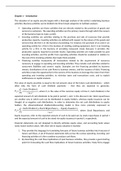Samenvatting
Summary Equity Valuation & Analysis (5th edition)
- Instelling
- Tilburg University (UVT)
This document contains a summary of the book Equity Valuation & Analysis (5th edition), by Lundholm and Sloan (2019), which is used for the course Financial Statement Analysis & Valuation. The summary covers all chapters, except for chapter 6 (which was not part of the final exam for the course ...
[Meer zien]





